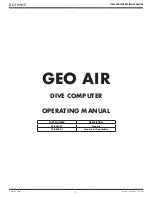
IM 12D03D02-01E
7-3
7
.
Measuring Principles of this Instrument
As shown in the above table, liquid conductivity changes with liquid temperature. So,
in order to compare conductivities, conductivity values at a fixed liquid temperature
are needed. This SC72 meter includes standard temperature conversion functions,
to display a liquid conductivity value converted to 25°C, so this meter can be used
for such conductivity measurement comparisons. Temperature compensation
coefficients of an NaCl solution are stored in the SC72 meter. No other temperature
coefficient setting is required (for NaCl solutions).
Table 7.2 shows temperature coefficients of various electrolytic solutions.
Table 7.2 Temperature Coefficients of Electrolytic Solutions
Solutions
Temperature coefficient (%/°C)
1mol/l
1/10mol/l
1/1000mol/l
Lithium benzoate solution
---
2.28
2.28
Sodium acetate solution
2.20
2.20
2.20
Potassium chloride solution
1.74
---
1.98
Sodium hydroxide solution
1.74
---
1.87
Sulfuric acid
1.07
---
1.38
• Finding Temperature Coefficient
If temperature coefficient tables containing the liquid to be measured can not be
found, measure conductivity twice at two liquid temperatures between 10 and 30°C
with temperature coefficient set to 0.00 and use the equation shown below to find
approximate temperature coefficient (α).
α
=
Temp. coef.
x 100 (%/°C)
K
2
– K
1
K
1
(t
2
– 25) – K
2
(t
1
– 25)
where
t
1
, t
2
: liquid temperature (°C)
K
1
: conductivity at t
1
K
2
: conductivity at t
2
(Calculation example)
To find the temperature coefficient of liquid with conductivity - 124.5 (S/cm at liquid
temperature 18.0°C and 147.6 (S/cm at liquid temperature 31.0°C, substitute t
1
=
18.0, t
2
= 31.0, K
1
= 124.5, K
2
= 147.6 in the equation above, thus we can obtain:
α
=
x 100
147.6 – 124.5
124.5 x (31.0 – 25) – 147.6 x (18.0 – 25)
=
x 100
23.1
747.0 – (–1033.2)
= 1.298
Set the temperature coefficient 1.30 in the SC72 meter (as meter allows three digits to
be entered).







































